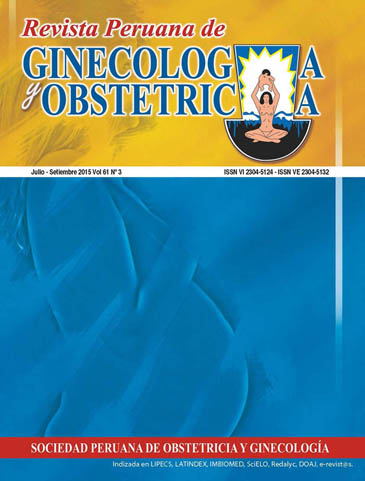Effects of early or late clamping of the umbilical cord on hemoglobin in infants born vaginally at 2700 meters above sea level
DOI:
https://doi.org/10.31403/rpgo.v61i1849Abstract
Several studies have shown that late cord clamping increases levels of hemoglobin in newborns. Objectives: To determine whether delayed umbilical cord clamping in term infants show higher hemoglobin levels than early clamping, investigation performed at 2700 m.a.s.l. Design: Prospective, randomized, double blind study. Setting: Gynecology and Obstetrics Department, Hospital Regional de Cajamarca, Peru. Participants: Newborns and their mothers. Methods: In January 2014, 100 pregnant women in labor with singleton pregnancies at term and without other risk factors were randomized to delayed clamping (when the umbilical cord stopped beats in 1-3 minutes) or early clamping (about 10 seconds after birth). Time was measured starting when baby shoulders appeared. A blood sample from the right newborn’s heel was obtained and placed in 2 capillaries, at birth and also at 6 hours of life; hemoglobin, hematocrit, and group and Rh factor were analyzed. Main outcome measures: Hemoglobin levels. Results: Ninety-one per cent of pregnant women did not have anemia and 9% had anemia; maternal blood group was O+ in 86%; 94% of newborns weighed 2 501-3 999 g, Apgar >7 was found in all newborns. Late clamping was done in 52 infants and early clamping in 48. The umbilical cord stopped beating at 2.67+-0.28 minutes. In 100% of infants with early clamping hemoglobin value was <15 mg/dL, and in late clamping 71.1% had hemoglobin 15.1 - 20.1 mg/dL and 28.9% over 20.1 mg/dL. There was no significant difference in newborn hemoglobin values whether the mother presented anemia or not. Conclusions: Late clamping resulted in better neonatal hemoglobin values. Average time for the umbilical cord stopping beats was 2.67 min. Maternal anemia did not affect neonatal hemoglobin at 2 700 m.a.s.l.Downloads
Download data is not yet available.
Downloads
Published
2015-11-12
How to Cite
Tapia Correa, R. M., & Collantes Cubas, J. A. (2015). Effects of early or late clamping of the umbilical cord on hemoglobin in infants born vaginally at 2700 meters above sea level. The Peruvian Journal of Gynecology and Obstetrics, 61(3), 237–240. https://doi.org/10.31403/rpgo.v61i1849
Issue
Section
Artículos Originales
















